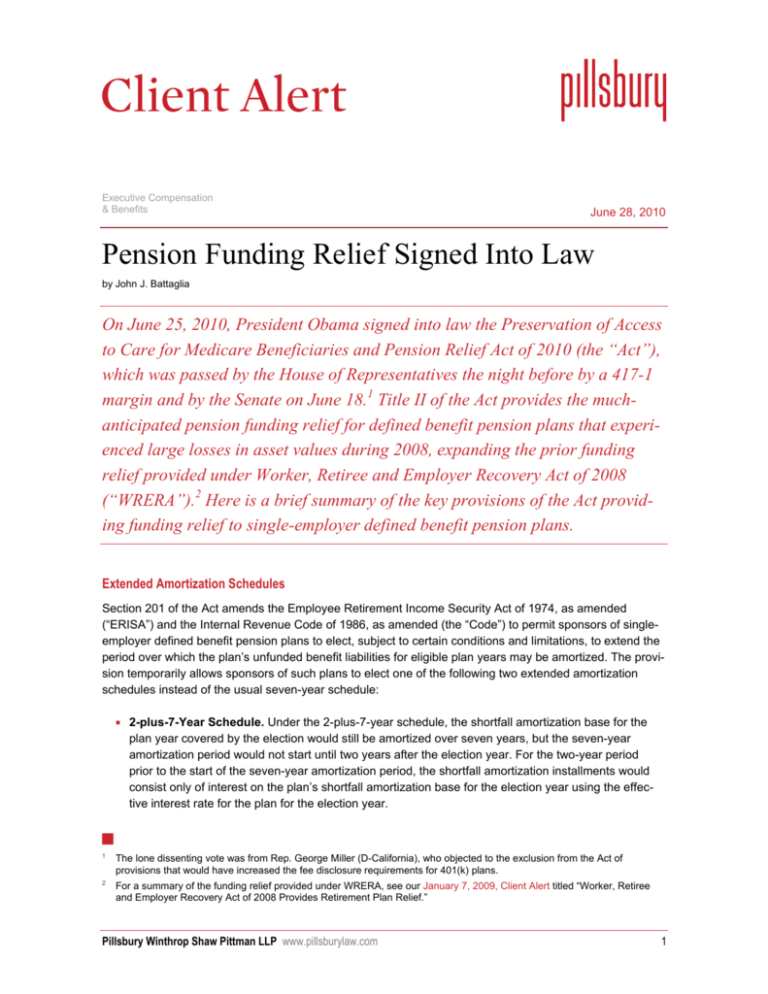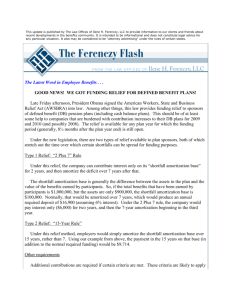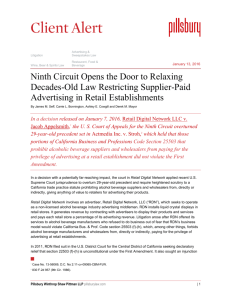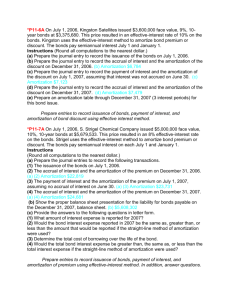
Alert
Executive Compensation & Benefits
Executive Compensation
& Benefits
June 28, 2010
Pension Funding Relief Signed Into Law
by John J. Battaglia
On June 25, 2010, President Obama signed into law the Preservation of Access
to Care for Medicare Beneficiaries and Pension Relief Act of 2010 (the “Act”),
which was passed by the House of Representatives the night before by a 417-1
margin and by the Senate on June 18.1 Title II of the Act provides the muchanticipated pension funding relief for defined benefit pension plans that experienced large losses in asset values during 2008, expanding the prior funding
relief provided under Worker, Retiree and Employer Recovery Act of 2008
(“WRERA”).2 Here is a brief summary of the key provisions of the Act providing funding relief to single-employer defined benefit pension plans.
Extended Amortization Schedules
Section 201 of the Act amends the Employee Retirement Income Security Act of 1974, as amended
(“ERISA”) and the Internal Revenue Code of 1986, as amended (the “Code”) to permit sponsors of singleemployer defined benefit pension plans to elect, subject to certain conditions and limitations, to extend the
period over which the plan’s unfunded benefit liabilities for eligible plan years may be amortized. The provision temporarily allows sponsors of such plans to elect one of the following two extended amortization
schedules instead of the usual seven-year schedule:
2-plus-7-Year Schedule. Under the 2-plus-7-year schedule, the shortfall amortization base for the
plan year covered by the election would still be amortized over seven years, but the seven-year
amortization period would not start until two years after the election year. For the two-year period
prior to the start of the seven-year amortization period, the shortfall amortization installments would
consist only of interest on the plan’s shortfall amortization base for the election year using the effective interest rate for the plan for the election year.
J
1
The lone dissenting vote was from Rep. George Miller (D-California), who objected to the exclusion from the Act of
provisions that would have increased the fee disclosure requirements for 401(k) plans.
2
For a summary of the funding relief provided under WRERA, see our January 7, 2009, Client Alert titled “Worker, Retiree
and Employer Recovery Act of 2008 Provides Retirement Plan Relief.”
Pillsbury Winthrop Shaw Pittman LLP www.pillsburylaw.com
1
Alert
Executive Compensation & Benefits
15-Year Schedule. Under the 15-year schedule, the shortfall amortization base for the plan year covered by the election would be amortized over the 15-year period beginning with the election year.
There is no requirement that the plan be an active plan that provides ongoing accruals in order to
elect the 15-year schedule.
A plan sponsor may elect to apply either of the two extended amortization schedules for no more than two
eligible plan years (which need not be consecutive years). For purposes of the Act, an eligible plan year
is any plan year that begins in 2008, 2009, 2010 or 2011.3 If the plan sponsor elects to apply one of the
extended amortization schedules to two eligible plan years, the same extended schedule must be elected
for both years. Plan sponsors who elect an extended amortization period for any eligible plan year must
give notice of the election to plan participants (and their beneficiaries) and the PBGC.
Conditions for Relief
As a condition to electing an extended amortization schedule, the Act requires that the shortfall amortization installments under each of the extended amortization schedules be increased, subject to certain limitations, dollar-for-dollar by an amount equal to the “installment acceleration amount” for any plan year
within the “applicable restriction period.”
Installment Acceleration Amount. The “installment acceleration amount” for a plan year is an
amount equal to the sum of (a) the aggregate of any “excess compensation” payable to employees
for the plan year and (b) the aggregate amount of extraordinary dividends and stock redemptions,
as determined under the Act, for such plan year. Excess compensation for this purpose is defined
as any compensation in excess of $1 million payable to an employee. Compensation that will
be taken into account for purposes of applying the $1 million rule includes all taxable compensation
for the plan year other than (i) commission income, (ii) restricted stock granted after February 28,
2010 with at least a five-year vesting period, (iii) certain payments and grants under binding contracts
that were in effect on March 1, 2010, that were not materially modified before the payments or grants
were made and (iv) compensation attributable to services performed prior to March 1, 2010. However,
amounts set aside in a trust to fund deferred compensation will be treated as current compensation
for purposes of applying the $1 million dollar rule, even if the amount is not currently taxable. The
$1 million excess compensation threshold will be indexed for inflation.
Applicable Restriction Period. If the plan sponsor elects the 15-year extended amortization schedule with respect to an eligible plan year, the applicable restriction period is the five-year period beginning with the election year or the first plan year beginning after December 1, 2009, if later. Otherwise,
the applicable restriction period is the three-year period beginning with the election year or the first
plan year beginning after December 1, 2009, if later.
These rules apply to all members of the electing plan sponsor’s controlled group. So, for example, if a
member of the electing plan sponsor’s controlled group pays excess compensation to some of its employees during a plan year, the sponsor must contribute to the plan the installment acceleration amount attributable to such excess compensation, even if the employees who were paid the excess compensation are
not covered by the plan.
J
3
A plan sponsor may elect one of the extended amortization schedules for an eligible plan year only if the due date for the
payment of the required minimum contribution for such plan year is on or after the Act’s date of enactment, i.e., June 25,
2010.
Pillsbury Winthrop Shaw Pittman LLP www.pillsburylaw.com
2
Alert
Executive Compensation & Benefits
Any installment acceleration amount that is required to be contributed to the plan would be in addition
to any required minimum contributions and would reduce future shortfall amortization installments in
reverse order. The installment acceleration amount for any plan year is capped at an amount sufficient
to fully pay the present value of the remaining unamortized portion of the shortfall amortization base covered by the election. Also, under a “no worse than present law rule,” the installment acceleration amount
for each plan year cannot exceed the excess of (a) the sum of the shortfall amortization installments for the
plan year and all preceding plans years in the amortization period that would have been required without
the funding relief over (b) the sum of the shortfall amortization installments for the plan year and all preceding plans years in the amortization period after taking into account the funding relief. To the extent that
an installment acceleration amount exceeds this annual limit for a plan year, such excess is carried over
and treated as an installment acceleration amount for the succeeding plan year. If the “7 plus 2” schedule
was elected, these carry-overs will end after the first plan year following the end of the applicable restriction period, i.e., after four years. For the 15-year schedule, the carry-overs end after the second plan year
following the end of the applicable restriction period, i.e., after seven years.
Other Funding Relief Under the Act
For purposes of applying the freeze on benefit accruals for plans that have a adjusted funding target
attainment percentage of less than 60% for a plan year, the Act provides that the plan’s 2008 funding
status will apply for plan years beginning on and after October 1, 2008 and before October 1, 2010 if such
application would result in a higher funding percentage. This provision extends by one year the WRERA
special look-back rule for funding-based benefit restrictions. Similar relief is provided under the Act for
purposes of applying the restriction on accelerated benefit distributions for plans with funding percentages
under 60%, but only for purposes of applying such restrictions to payments under a social security leveling
option that accelerates payments under the plan before, and reduces payments after, a participant starts
receiving social security benefits.
Effective Date
The provisions in the Act relating to the expanded amortization schedules are effective to plan years
beginning after December 31, 2007. According, plan sponsors may immediately benefit from such
provisions.
What Should Plan Sponsors Do Now?
We recommend that sponsors of defined benefit plans obtain advice from their plan actuary on whether
it makes sense for them to elect the extended amortization schedules for any plan year beginning in 20082011 and, if so, which of the two available extended schedules would be best for them. When deciding
whether to elect an extended amortization schedule, sponsors will need to consider the impact on such
relief of any installment acceleration amounts that may potentially need to be paid as a result of the its own
compensation structure and dividend and redemption policies, as well as those of each member of its
controlled group. We are, of course, available to help advise on these issues.
Pillsbury Winthrop Shaw Pittman LLP www.pillsburylaw.com
3
Alert
Executive Compensation & Benefits
If you have any questions about the content of this client alert, please contact the Pillsbury attorney with
whom you regularly work or any of the members of the Executive Compensation & Benefits group.
New York
Susan P. Serota (bio)
+1.212.858.1125
susan.serota@pillsburylaw.com
Peter J. Hunt (bio)
+1.212.858.1139
peter.hunt@pillsburylaw.com
Scott E. Landau (bio)
John J. Battaglia (bio)
+1.212.858.1598
+1.212.858.1738
scott.landau@pillsburylaw.com
john.battaglia@pillsburylaw.com
Mark C. Jones (bio)
Kathleen D. Bardunias (bio)
+1.212.858.1905
kathleen.bardunias@pillsburylaw.com
+1.212.858.1430
mark.jones@pillsburylaw.com
Bradley A. Benedict (bio)
+1.212.858.1523
bradley.benedict@pillsburylaw.com
Washington, DC / Northern Virginia
Howard L. Clemons (bio)
+1.703.770.7997
howard.clemons@pillsburylaw.com
San Diego—North County
Jan H. Webster (bio)
Daniel N. Riesenberg (bio)
+1.858.509.4012
+1.858.847.4130
jan.webster@pillsburylaw.com
daniel.riesenberg@pillsburylaw.com
Kenneth E. Bonus (bio)
Lori Partrick (bio)
+1.858.509.4087
lori.partrick@pillsburylaw.com
+1.858.847.4206
kenneth.bonus@pillsburylaw.com
San Francisco
Christine L. Richardson (bio)
+1.415.983.1826
crichardson@pillsburylaw.com
Silicon Valley
Cindy V. Schlaefer (bio)
+1.650.233.4023
cindy.schlaefer@pillsburylaw.com
Grace Chen (bio)
+1.650.233.4873
grace.chen@pillsburylaw.com
This material is not intended to constitute a complete analysis of all tax considerations. Internal Revenue Service regulations
generally provide that, for the purpose of avoiding United States federal tax penalties, a taxpayer may rely only on formal
written opinions meeting specific regulatory requirements. This material does not meet those requirements. Accordingly, this
material was not intended or written to be used, and a taxpayer cannot use it, for the purpose of avoiding United States federal
or other tax penalties or of promoting, marketing or recommending to another party any tax-related matters.
This publication is issued periodically to keep Pillsbury Winthrop Shaw Pittman LLP clients and other interested parties
informed of current legal developments that may affect or otherwise be of interest to them. The comments contained herein
do not constitute legal opinion and should not be regarded as a substitute for legal advice.
© 2010 Pillsbury Winthrop Shaw Pittman LLP. All Rights Reserved.
Pillsbury Winthrop Shaw Pittman LLP www.pillsburylaw.com
4







